
Opal Botae: Sɛnea Wɔde Opals Graded & Prices of Each Type
 Opals yɛ soronko wɔ aboɔden abo afoforo ho wɔ akwan pii so, na ɛno trɛw kɔ sɛnea wɔde nkyerɛwde gu mu no so. Saa aboɔden abo yi wɔ wɔn ankasa bo a ɛsom ho gyinapɛn ahorow, ɛwom sɛ ebia wobebu opal ahorow biara sɛ ɛsom bo kɛse esiane nneɛma ahorow nti sen ahorow afoforo de.
Opals yɛ soronko wɔ aboɔden abo afoforo ho wɔ akwan pii so, na ɛno trɛw kɔ sɛnea wɔde nkyerɛwde gu mu no so. Saa aboɔden abo yi wɔ wɔn ankasa bo a ɛsom ho gyinapɛn ahorow, ɛwom sɛ ebia wobebu opal ahorow biara sɛ ɛsom bo kɛse esiane nneɛma ahorow nti sen ahorow afoforo de.
Nea yɛaka yi nyinaa akyi no, opal betumi ayɛ aboɔden abo a ɛyɛ den sɛ wobebu no sɛ ɛsom bo no mu biako. Nea enti a ɛte saa no gyina sɛnea ɛsakrasakra no so, efisɛ ɛsɛ sɛ wɔn a wɔde grade no susuw opal ko, ne mfiase, ne kɔla, sɛnea ɛhyerɛn, ne nneɛma afoforo pii ho.
So opal yɛ ɔbo a ne bo yɛ den? Ebetumi aba saa, nanso opal bo gu ahorow kɛse wɔ ahorow ahorow ne ne su ahorow mu. Sɛ wopɛ sɛ wuhu a, opal a ne bo yɛ den sen biara a wɔatɔn pɛn ne Fire (anaasɛ Ogya) Queen Opal, a John D. Rockefeller tɔɔ no wɔ 1949 mu de gyee £75,000, a ɛkyerɛ bɛyɛ $3,620,700 nnɛ! Nhwɛso foforo a ne bo yɛ den ne Virgin Rainbow , opal kɛse bi a efi awosu mu a ɛhyerɛn wɔ sum mu a mprempren ne bo boro dɔla ɔpepem biako.
Wobɛyɛ dɛn ahu sɛ opal som bo? Ade a edi kan a ɛsɛ sɛ wuhu sɛnea opal som bo ne sɛ wubesua sɛnea wɔde opal ahorow hyehyɛ mu ne nneɛma a ɛsɛ sɛ wohwɛ yiye wɔ ho.
Saa akwankyerɛ yi bɛkyekyɛ opal bo a ɛsom biara mu, nsɛmfua a wɔde hyɛ mu a ɛsɛ sɛ wohu, opal ahorow ahorow, ne bo ko a ɛsɛ sɛ wɔhwɛ kwan.

Ɔkwan Bɛn so na Wɔma Opals Grade? 11 Nneɛma a Ɛsom Bo
Botae a ɛwɔ opal so no ba fam wɔ nneɛma pii so, efi aboɔden abo a wɔde di dwuma daa te sɛ nea emu da hɔ ne kɔla so kosi nkyerɛwde soronko a ɛwɔ opal te sɛ play-of-color ne pattern so.
Opal bo yɛ ahe wɔ carat biako mu? Ɛno gyina ne su ne nneɛma a yɛbɛka ho asɛm wɔ ase hɔ no so.
Awerɛhosɛm ne sɛ, opal bo a ɛsom nyinaa ho akontaabu biara nni hɔ a ebetumi akyerɛ wo sɛnea opal bo yɛ pɛpɛɛpɛ, te sɛ nea ɛwɔ hɔ ma aboɔden abo te sɛ abohene. Mmom no, ɛsɛ sɛ abenfo susuw nneɛma ahorow a ɛsom bo ho na ama wɔahu nea opal pɔtee bi bo yɛ.
Nneɛma bi wɔ hɔ a ebetumi aboa te sɛ Opal Smart Chart software package no, nanso bɛyɛ $145, eyi nyɛ nea obiara betumi anya. Ɛno nti na yɛayɛ akwankyerɛ bi a ɛbɛboa wo ma woahu wo opal no boɔ!
Opal boɔ nneɛma 11 a yɛbɛkyekyɛ mu ne:
Opal no su
Kɔla (Nipadua Nneyɛe) .
Play-of-Color Akwankyerɛ a Wɔde Di Dwuma
Play-of-Color Nhwɛso a Wɔde Di Dwuma
Hann a ɛhyerɛn
Ɛda adi pefee
Nneɛma a wɔyɛ no pefee
Shape anaa Twitwa
Ɔman a Wofi Mu
Abɔde ne Nneɛma a Wɔde Yɛ Nneɛma ne Simulant
Ayaresa ahorow
Sɛ abenfo de opal bi kyerɛ a, wɔyɛ saa wɔ tebea horow a ɛkɔ so daa mu, na wɔtaa hwɛ ɔbo no wɔ hann a ɛyɛ hyew anaa awia hann ase. Sɛ woretɔ opals a, ɛho hia sɛ wuhu aboɔden abo no fi baabiara a wubetumi wɔ kanea ahorow pii mu.
Anamɔn a edi kan wɔ opal bo a wobɛkyerɛ mu ne sɛ wobɛkyerɛ opal ko a worehwɛ.
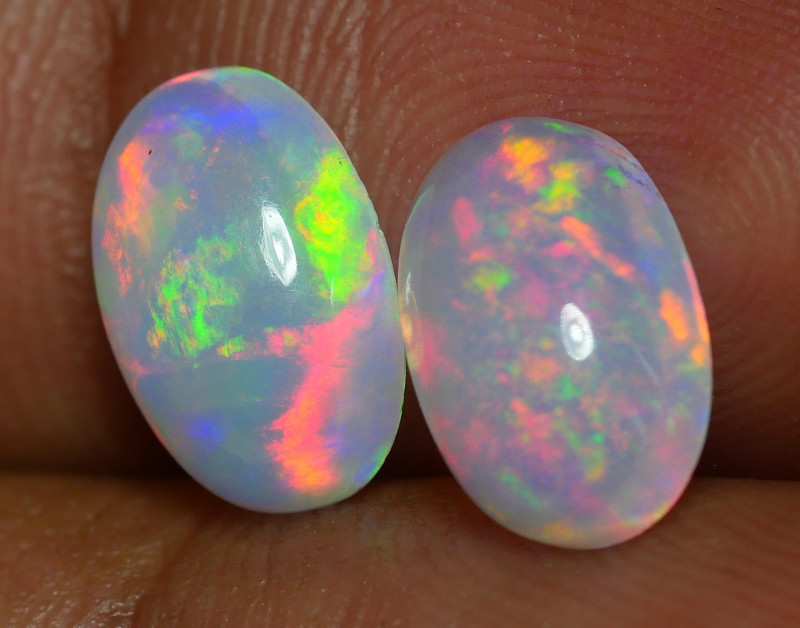 Mfonini a ɛwɔ atifi hɔ no: Opal a ɛsom bo
Mfonini a ɛwɔ atifi hɔ no: Opal a ɛsom bo
1. Opal no su
Opal ahorow bi som bo sen afoforo kɛkɛ, mpɛn pii no esiane sɛ wɔntaa nhu nti.
Opal akuw ne nketewa pii wɔ hɔ, nanso opal ahorow biara hyɛ akuw abien a ɛka bom no mu biako ase: opal a ɛsom bo vs. opal a wɔtaa de di dwuma .
Opal a ɛsom bo da play-of-color adi na opals a wɔtaa de di dwuma no nkyerɛ. (Hyɛ no nsow: Wobetumi afrɛ Play-of-color nso color-play, flashes, anaa ogya). Nsonsonoe no yɛ mmerɛw, nanso edi dwuma titiriw wɔ opal bo a ɛsom no mu. Sɛ yɛka ne nyinaa bom a, ɛkame ayɛ sɛ bere nyinaa na opal a ɛsom bo som bo sen opal a wɔtaa de di dwuma.
Kɔla a ɛhyerɛn a ɛda adi no nso betumi aka bo a ɛsom. Nneɛma a ɛyɛ kɔkɔɔ ne borɔdɔma a ɛhyerɛn titiriw no ho yɛ na na ɛsom bo sen violet ne bruu a ɛhyerɛn.
Wɔ nsonsonoe a ɛsom bo ne nea wɔtaa yɛ no akyi no, nneɛma te sɛ wɔn mfiase, nea ɛka ho, nhyiam (kyerɛ sɛ doublet, triplet, mosaic), nea wɔhyehyɛ (abɔde mu ne nea wɔde ayɛ), ne nipadua nne nso na ɛtetew opal grading mu.

2. Kɔla (Nipadua Nneyɛe) .
Mpɛn pii no, kɔla ne ade titiriw a ɛma opal bo yɛ den. Grading opal kɔla kyerɛ sɛ wobɛhwɛ ne nipadua nne, a ɛkyerɛ ne nnyinaso anaa akyi kɔla. Sɛnea ɛte no, ɛtɔ mmere bi a wɔfrɛ “nipadua nne” “akyi kɔla” anaa “gyinabea nne.”
Nipadua nne yɛ soronko wɔ play-of-color ne hann ho, nanso ebetumi aka abien no nyinaa. Nipadua mu nne a ɛyɛ tuntum bɛma kɔla a wɔde di agoru no ayɛ nea ɛhyerɛn sen sɛnea ɛte wɔ nipadua mu nne a ɛyɛ hare so, na ɛbɛma opals a ɛsom bo a ɛyɛ tuntum no som bo asen nea ɛyɛ kɔla a ɛyɛ hare.
Nea eye ne sɛ, Opal Association of Australia yɛɛ nipadua nne ho akwankyerɛ a ɛyɛ mmerɛw a ɛbɛma ayɛ mmerɛw sɛ wɔbɛkyekyɛ mu.
Nnyigyei ahorow no fi N1 kɔ N7 anaa N9, egyina nea ɔreyɛ abasobɔde so. N1 kosi N4 kyerɛkyerɛ nipadua mu nne a ɛyɛ sum sen biara mu bere nyinaa. Ebia N5 kosi N7 bɛkyerɛkyerɛ opal a ɛyɛ fitaa mu, nanso wɔn a wɔde N1-N9 nhyehyɛe no di dwuma no ka N5 ne N6 ho asɛm sɛ opal tuntum na N7 kosi N9 sɛ opal a ɛyɛ hann/fitaa.
Saa nkyekyɛmu a wɔde hyɛ mu yi di opals ahodoɔ titire mmiɛnsa no akyi: tuntum, tuntum/akuturuku, ne hann/fitaa. Nokwarem no, ɛno nkyerɛ opal kɔla afoforo a mpɛn pii no ɛba fam wɔ nea ɛntaa nsi no ho. Kɔla a ɛyɛ hyew ho yɛ na, bere a ahabammono ne bruu abu so. Purple ne violet ho yɛ na, nanso ɛnyɛ nea ɛsom bo te sɛ kɔkɔɔ anaa borɔdɔma.
Bio nso, ɛnne ne sɛnea opal nipadua mu nne yɛ ma no ka ne bo. Wɔbu kɔla a ɛho tew a ɛwɔ saturation a ɛhyerɛn no sɛ ɛsom bo kɛse sen kɔla a ɛyɛ hare, ɛyɛ kusuu, anaa nea ɛho ntew (kyerɛ sɛ kɔla ahorow a ɛwɔ ase nnyigyei).
Wubetumi ahu Opal Body Tone nhyehyɛe a ɛwɔ atifi hɔ no.

3. Play-of-Color: Akwankyerɛ
Play-of-color a wɔda no adi no ma opal som bo kɛse dedaw, nanso opal pii da saa ogya nkɛntɛnso yi adi. Kɔla a wɔde di agoru no afã horow bi ma saa opal ahorow a ɛsom bo no bi som bo sen afoforo, te sɛ akwankyerɛ.
Akwankyerɛ kyerɛ sɛnea opal bi a wɔde kɔla di agoru no hyerɛn a wotumi hu fi mmeae bi nkutoo. Opal a ɛsom bo a ɛnyɛ nea ɛkyerɛ kwan (ɛtɔ mmere bi a wɔfrɛ no “anim nyinaa”) bɛda hann koro no ara adi afi baabiara. Eyinom som bo koraa nanso wɔntaa nhu.
Wɔtaa de akwankyerɛ gyinabea afoforo no toto ho sɛ:
Akwankyerɛ Kakra: Hann no sesa kakra wɔ afã horow nanso ɛnsesa hann dodow a ɛboro biako (yɛbɛka hann dodow ho asɛm akyiri yi)
Somewhat Directional : Anyɛ yiye koraa no, hann no sesa hann no fã biako kɔ akwan horow bi so
Very Directional : Hann no yera dodow no ara wɔ akwan bi so
Highly Directional : Hann no yera koraa wɔ mmeae bi, na mpɛn pii no ɛhyerɛn wɔ ɔkwan biako pɛ so
Opal dodow no ara bɛda akwankyerɛ bi adi, nanso akwankyerɛ kakraa bi kyerɛ sɛ ɛsom bo kɛse. Sɛ wɔhwere hann fi anim anim a, eyi betumi asɛe bo a ɛsom kɛse sen sɛ wɔbɛhwere hann afi nkyɛn.
Ebia opal agude ko a wɔde yɛ no nso bɛkyerɛ ɔkwan a eye sen biara a wɔfa so kɔ baabiara. Opal a ɛhyerɛn sen biara bere a wohwɛ no tẽẽ no ma ɛyɛ ring a eye, bere a opal a ɛhyerɛn sen biara bere a ɛda hɔ no yɛ pendant a eye.
Ade foforo a ɛwɔ kɔla-agoru mu ne nsusuwso biara a epue wɔ opal no so.

4. Agorudi a Wɔde Kɔla Di Dwuma: Nhwɛso
Pattern kyerɛ sɛnea opal bi a wɔde kɔla di agoru no nsusuwii ne nhyehyɛe ahorow. Nhwɛso ahorow du du pii wɔ hɔ a wubetumi ahu na woasua ho ade wɔ yɛn opal nsusuwso akwankyerɛ no mu .
Pattern nso betumi asusuw play-of-color kyekyɛ ho; kɔla kyekyɛ a ɛtrɛw pɛpɛɛpɛ no ye sen kɔla-agoru a ɛwɔ mpɔtam hɔ. Nhwɛso ahorow a ɛwɔ asetɔre, anaa “mmeae a awu” a wontumi nhu kɔla a wɔde di agoru biara no som bo kɛse.
Bere a sɛnea nsusuwso bi pɛ no gyina nea wɔpɛ so kɛse no, obi da nsow sɛ nea ɛntaa nsi na ɛsom bo sen biara : harlequin nsusuwso no .
Harlequin opals wɔ ɔkwan a ɛtaa ba a ɛyɛ ahinanan anaa abohene a ɛtwetwe. Ahorow a wɔntaa nhu no wɔ harlequin kɔkɔɔ nsusuwso wɔ opals a ɛyɛ tumm yiye a efi Lightning Ridge, Australia, na wobetumi agye dɔla 5,000 kosi dɔla 30,000 wɔ carat biako mu.
Nhwɛso afoforo a wɔntaa nhu, a ɛsom bo no bi ne:
Owia a Ɛpae/Nsoromma a Ɛpae
Frɛmfrɛm abo
Nsateaa nkyerɛwee
Neon flash a ɛyɛ hyew
Mackerel a wɔfrɛ no mackerel
Asɔredan Kɛse no
Chinafo nkyerɛwee
Ogya a ɛrehuruhuruw
Mframa a wɔde yɛ adwuma
Mpɛn pii no, nsusuwso akɛse a ɛtrɛw te sɛ flagstone som bo sen nketewa a ɛbɛn te sɛ pinfire.
Ɛmfa ho sɛnea wɔayɛ no, kɔla a wɔde di agoru a ɛhyerɛn no yɛ ade titiriw a ɛma opal bo yɛ den.

5. Hann a ɛhyerɛn
Akyinnye biara nni ho sɛ hann ne ade titiriw a ɛma opal bo yɛ den, wɔ nipadua nne akyi. Ɛtɔ mmere bi mpo a, hann ho hia sen nipadua no nne.
Opal a ɛhyerɛn a kɔla abien pɛ na ɛwɔ ne kɔla-agoru no mu taa som bo sen opal a ɛyɛ kusuu a kɔla pii a ɛhyerɛn wom.
Hann yɛ tẽẽ koraa sen nneɛma te sɛ nsusuwii anaa akwankyerɛ. Te sɛ nipadua mu nne ahorow no, wɔde nhyehyɛe a ɛyɛ mmerɛw a Australia Opal Fekuw no ayɛ na ɛkyekyɛ hann nkyerɛwde mu.
Opal hann no grade ahorow no fi ase fi nea ɛhyerɛn sen biara wɔ B1 kosi nea ɛyɛ dull sen biara wɔ B7. Wɔtaa frɛ B1 sɛ “brilliant,” bere a B2 kosi B3 yɛ “hyerɛn” na B4 kosi B7 yɛ “anifere.”
Wubetumi ahu Opal Brightness chart a ɛwɔ atifi hɔ no.

6. Nsɛm a emu da hɔ
Clarity kyerɛkyerɛ dodow a nneɛma a wotumi hu a wɔde ka aboɔden abo mu ho. Abasobɔdefo binom de ka ho ne nea ɛda adi pefee bere a wɔde abasobɔde a emu da hɔ ma efisɛ nneɛma abien no betumi anya wɔn ho wɔn ho so nkɛntɛnso.
Sɛ emu nneɛma a wɔde ka ho da nkyɛn a, nea emu da hɔ nso betumi aka akyi nkekae te sɛ mpaapaemu ne kraman ho. Crazing ne mpaapaemu te sɛ nea ɛte saa ara, nanso crazing kyerɛkyerɛ mpaapaemu a ɛte sɛ wɛb a efi nsu a ɛyera mu ba no ho asɛm.
Ade foforo a wɔde ka ho ne matrix, a ɛkyerɛ sɛ opal bi frafra ɔbotan a ɛyɛe wɔ mu no mu (“abotan a ɛgye no”). Mpɛn pii no, matrix kyerɛ sɛ ɛsom bo a ɛba fam, ɛwom sɛ nneɛma bi wɔ hɔ a ɛyɛ soronko de.
Dodow a nneɛma a wɔde ka ho ne nkekae a wotumi hu wɔ opal mu no, dodow no ara na ne pefeeyɛ grade ne ne bo so tew. Crazed opal bo titiriw taa yɛ ɔha biara mu nkyem 10 kosi 20 pɛ wɔ opal a ɛte saa ara a ɛnyɛ kraman, sɛ wɔtɔn koraa mpo a. Mpaapaemu a ɛwɔ opal no anim (ɔfã a ɛwɔ soro, a wotumi hu kɛse) nso taa ma opal no bo nyɛ den koraa.
Sɛ nneɛma a wɔde ka ho, mpaapaemu, ne kraman da nkyɛn a, opal nkekae afoforo a ebetumi aba no bi ne:
Pits
Nneɛma a abubu
Mpaapaemu a ɛwɔ hɔ
Ntrɛwmu a ɛyɛ fitaa a wɔde webbing ayɛ
Mfɛnsere (kɔla anaa nea ɛdannan kakraa bi anaasɛ enni opal a ɛwɔ afã horow no mfinimfini) .
Potch lines (opal a wɔtaa de di dwuma, anaa “ potch ,” a ɛtwa play-of-color a ɛwɔ opal a ɛsom bo anim no ntam) .
Ɛnyɛ bere nyinaa na potch lines no brɛ ne bo ase kɛse; ɛtɔ mmere bi a wobetumi ayɛ nsusuwso ahorow a ɛyɛ anigye. Saa ara na nneɛma afoforo a wɔde ka ho no betumi ama wɔanya opal ahorow a wɔpɛ, te sɛ dendritic opal.
Pro Tip : Ntɔ opals a wɔtɔn wɔ nsu mu. Opal dodow no ara wɔ abon araa ma ɛtwetwe nsu no, na ɛte sɛ nea ɛma ne carat mu duru yɛ kɛse. Nea ɛho hia sen saa no, nsu a ɛtwetwe no betumi akata nkekae ne mpaapaemu so.

7. Nneɛma a wɔyɛ no pefee
Transparency yɛ sɛnea hann dodow fa aboɔden abo mu. Opals betumi afi nea ɛyɛ mmerɛw koraa so kosi nea ɛnyɛ nea ɛda adi pefee so. Nanso, opal dodow no ara yɛ nea ɛnyɛ nea ɛda adi kosi nea ɛyɛ hann.
Opals a ɛyɛ transparent a wɔntaa nhu — te sɛ nsu opals, crystal opals, ne ogya opals — taa yɛ nea ɛsom bo kɛse, nanso Opals bi a ɛyɛ tuntum ye bere a opaque no. Mpɛn pii no, mununkum brɛ bo a ɛsom ase.

8. Nsusuwii anaa Twitwa
Te sɛ nea emu da hɔ no, twa yɛ nneɛma a wɔde hyɛ aboɔden abo a wɔde hyɛ mu a ɛfata a ɛfa opal bo ho no mu biako.
Dɛn ne nea eye sen biara a wɔatwa ama opal? Wɔtwitwa opal dodow no ara yɛ no cabochons , ɛwom sɛ biako a ɛka ho ne ogya opal a wɔtaa yɛ afã horow de. Faceting betumi aka opals pii sɛnea ɛtra hɔ kyɛ ne sɛnea wɔde kɔla di agoru no wɔ ɔkwan a enye so.
Opal cabochons a eye sen biara:
Wɔyɛ symmetrical
Ɛnyɛ teateaa dodo anaasɛ ɛnyɛ den dodo (mpɛn pii no anyɛ yiye koraa no 2mm gye sɛ wɔatwitwa de adi dwuma sɛ doublet/triplet) .
Nya dome a ɛyɛ kurukuruwa yiye, ɛyɛ ma, ɛyɛ torotoro a enni nsensanee anaasɛ nsensanee biara (gye sɛ ɛyɛ asikre paanoo cabochon) .
Kyerɛ play-of-color a ɛsen biara a akwankyerɛ biara nni mu
Ɛnyɛ nea ɛtrɛw dodo anaasɛ ɛyɛ teateaa dodo (sɛ ɛyɛ oval a) .
Wɔtaa twitwa opals a ɛdɔɔso te sɛ opal fitaa a wɔtaa yɛ no akɛse a wɔahyɛ da ayɛ (nea ɛfata agude nhyehyɛe a ne kɛse yɛ pɛpɛɛpɛ a enhia sɛ wɔyɛ no sɛnea wɔpɛ) te sɛ 6x4mm, 7x5mm, anaa 8x6mm. Ebia ahorow afoforo te sɛ boulder opals behia sɛ wɔyɛ freeform shape.
 Mfonini a ɛwɔ atifi hɔ no: Peruvian opal a ɛyɛ ahabammono
Mfonini a ɛwɔ atifi hɔ no: Peruvian opal a ɛyɛ ahabammono
9. Ɔman a Wofi Mu
Ɛnyɛ bere nyinaa na opal fibea nya ne bo so nkɛntɛnso, nanso ebetumi ayɛ ade a ɛde ba. Australia ne ɔman a edi kan a wɔyɛ opal, na wonya opal bɛyɛ ɔha biara mu nkyem 95 fi wiase nyinaa. Ethiopia ne ɔman a ɛto so abien a ɛyɛ opal sen biara.
Opal ahorow bi wɔ mmeae bi nkutoo, na emu pii yɛ mmeae a ɛwɔ Australia. Nea ɛka ho no, mmeae bi a wotu fagude anya din bere tenten sɛ wɔyɛ opal rough a ɛkorɔn. Eyinom nyinaa ne nneɛma abien a enti Australia opal bo taa yɛ den .
Nanso bere a Australia ne Ethiopia opal bo betumi ayɛ kɛse no, ɛsɛ sɛ wosusuw nneɛma afoforo no nyinaa ho wɔ opal biara ho.
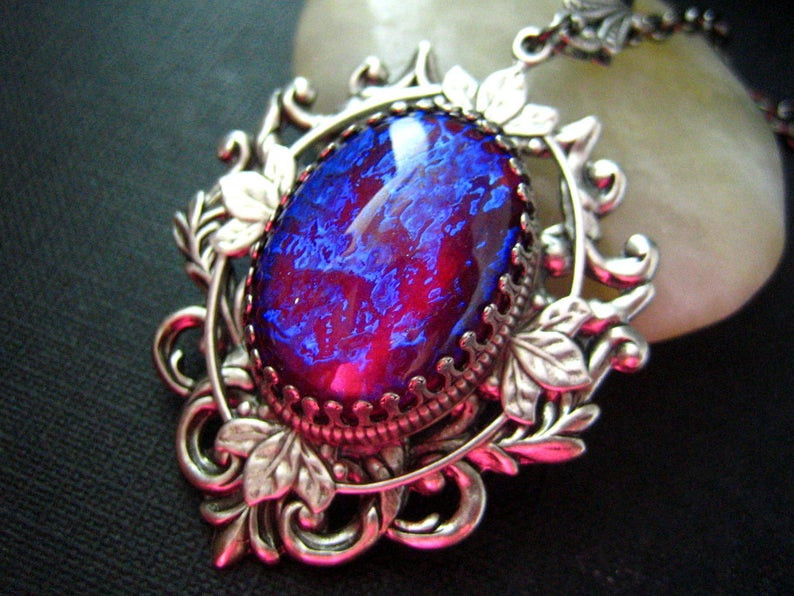 Mfonini a ɛwɔ atifi hɔ no: Dragon’s Breath opal
Mfonini a ɛwɔ atifi hɔ no: Dragon’s Breath opal
10. Abɔde ne Nneɛma a Wɔde Yɛ Nneɛma ne Simulant
Wɔyɛ opals a wɔayɛ wɔ afiri a wɔde yɛ nhwehwɛmu mu sɛnea ɛbɛyɛ a ɛwɔ honam fam ne nnuru a ɛte sɛ abɔde mu nneɛma no ara pɛ. Simulants anaa imitation opals yɛ nneɛma a ɛne opals nni abusuabɔ a ɛte sɛ wɔn wɔ ne hwɛbea te sɛ ahwehwɛ anaa resin.
Abɔde mu opals som bo sen nneɛma a wɔde yɛ nneɛma anaa nea wɔde yɛ mfonini bere nyinaa. Bere a mpɛn pii no, opals a wɔayɛ no yɛ dɔla kakraa bi pɛ no, ɛda so ara som bo sen nea wɔde yɛ mfonini.
Ɛkame ayɛ sɛ opal ahorow a wɔayɛ no kɔla biara na ɛtaa da kɔla a wɔde di agoru denneennen adi Opal ahorow bi a wɔayɛ no bi ne:
Aurora Opal na ɔkyerɛwee
Hyɛ no nsow: “Opalite” nso betumi akyerɛ abɔde mu opal a ɛyɛ ahabammono a dendritic ka ho.
 Mfonini a ɛwɔ atifi hɔ no: Ethiopiafo Welo opal a wɔayam no wusiw
Mfonini a ɛwɔ atifi hɔ no: Ethiopiafo Welo opal a wɔayam no wusiw
11. Ayaresa & Nneɛma a Wɔde Afrafra
Bere a wɔntaa nyɛ opal ho adwuma te sɛ aboɔden abo afoforo te sɛ safir no, opal ayaresa ahorow bi wɔ hɔ. Opals a wɔayɛ ho adwuma no bo nyɛ den te sɛ opals a wɔayɛ ho adwuma.
Opal ayaresa ahorow no bi ne:
Sugar & Acid : Opal ayaresa a wɔtaa yɛ, wɔtaa yɛ ma Andamooka matrix opals
Sigaretnom : Ɛtaa ba sɛ wɔde hydrophane nhwɛsode ahorow yɛ Ethiopiafo opals “tuntum” anaasɛ wɔde ma matrix opals yɛ tuntum
Dye : Ɛtaa ba Ethiopiafo opal ahorow bi mu , mpɛn pii no wɔde yɛ opal “tuntum.”
Resin Treatment : Ɛtɔ da bi a wɔyɛ wɔ Queensland boulder opals so na ama opal layer no abɔ yiye wɔ host rock no ho
Fracture Filling / Oiling : Ɛtaa ba opals pii a nkekae te sɛ crazing; Oiling ne Opticon kakra abu so ma hydrophane opals ne ma stabilizing crazed opals
Surface Coating : Nnuru foforo a wɔde yɛ nsu a ɛyɛ hyew (CVD) a wɔyɛ wɔ Queensland abotan so opal binom so na ama atumi atra hɔ akyɛ
Wɔyɛ opal ayaresa dodow no ara de yɛ opals a egyina tuntum so, esiane sɛ saa ahorow yi bo yɛ den nti. Ethiopiafo hydrophane opals yɛ nea ɛwɔ abon koraa na ɛnyɛ den sɛ ɛbɛtwetwe, na ɛma ɛyɛ nhwɛsode a agye din a wɔde sa yare. Andamooka matrix opal dodow no ara yɛ asikre & acid ayaresa.
Ɛsɛ sɛ adetɔnfo da ayaresa ahorow adi bere nyinaa, nanso w’ankasa wubetumi nso asɔ opal ayaresa ahorow bi ahwɛ .
Opal nsakrae foforo ne sɛ wɔbɛfa abɔde mu opals na wɔde nneɛma a wɔayɛ aka ho de ayɛ opals a wɔabom ayɛ : doublets , triplets , mosaic, ne chip opals. Wɔfrɛ abɔde mu opals a ɛnyɛ nneɛma a wɔabom ayɛ (anaasɛ “wɔaboaboa ano”) no opal a ɛyɛ den.
Mpɛn pii no, doublet opal bo bɛyɛ ɔha biara mu nkyem 15 kosi 35 wɔ opal a ɛyɛ den a ne ho yɛ pɛ no bo mu, ɛwom sɛ doublet a ɛyɛ papa betumi adu opal a ɛyɛ den a ɛte sɛ nea ɛte saa ara bo ɔha biara mu nkyem 50 de. Triplet opal bo no sua koraa, bɛyɛ ɔha biara mu nkyem 1 pɛ wɔ opal a ɛyɛ den a ɛte sɛ nea ɛte saa ara bo mu.
Afei, ma yɛnhwɛ sɛnea nneɛma a ɛwɔ atifi hɔ no nyinaa fa opal bi abasobɔde mu.

Dɛn Ne Opal ahorow no mu abasobɔde ahorow?
Nea ɛnte sɛ aboɔden abo a agye din te sɛ diamond ahorow a wɔde asi hɔ no, aban mpanyimfo nni hɔ ma opals. Nanso, adetɔnfo ne nnwuma mu akannifo ahorow ayɛ wɔn ankasa opal abasobɔde ahorow.
Nea edi kan no, yɛbɛhwɛ opal grade categories a efi International Gem Society (IGS) hɔ.
IGS Opal Nkyekyɛm a Wɔde Ma
Amanaman Ntam Aboɔden abo Fekuw no wɔ opal abasobɔde ahorow 5 a opal ho ɔbenfo Oduruyɛfo Paul Downing na ɔyɛe, a wɔaka ho asɛm wɔ ase hɔ no nnidiso nnidiso sɛnea esua koraa kosi nea ɛsom bo kɛse.
Saa akuw yi susuw kɔla (nipadua nne ne kɔla a wɔde di agoru nyinaa), kɔla a wɔde di agoru no akwankyerɛ, su a wɔatwa, ne sintɔ ahorow (a wɔfrɛ no pefeeyɛ ne nea ɛda adi pefee) ho.
Extra Fine opal bo a ɛsom wɔ carat biara mu no bɛyɛ kɛse kɛse asen Below Commercial.
Below Commercial : Kɔla a ɛyɛ mmerɛw, hann a ɛba fam; Kakraa bi & akwankyerɛ kɛse play-of-color; Twitwa no nyɛ pɛpɛɛpɛ, ɛyɛ den dodo, anaasɛ ɛnyɛ den sɛnea ɛsɛ; Nneɛma a wɔde ka ho a wotumi hu kɛse anaa matrix
Commercial : Kɔla biako kosi abien, hann a ɛyɛ kusuu; Very to bi akwankyerɛ play-of-color; Fafa a ɛnyɛ pɛpɛɛpɛ, ɛyɛ den dodo, ɛnyɛ den sɛnea ɛsɛ; Nneɛma bi a wɔde ka ho a wotumi hu
Eye : Kɔla ahorow pii, hann pa; Biribi kosi akwankyerɛ kakra play-of-color; Ntwitwiridii pa kosi nea eye kyɛn so; Nneɛma nketenkete a wotumi hu a wɔde ka ho
Fine : Kɔla ahorow pii, hann kɛse; Akwankyerɛ kakra anaasɛ ɛnyɛ akwankyerɛ play-of-color; Ntwitwiridii pa kosi nea eye kyɛn so; Nneɛma a wɔde ka ho a wotumi hu biara nni hɔ a wɔde aniwa nkutoo na ɛyɛ
Extra Fine : Kɔla biara, hyerɛn a ɛhyerɛn; Play-of-color a ɛnyɛ akwankyerɛ a wotumi hu fi afã horow nyinaa; Ntwitwiridii pa kosi nea eye kyɛn so; No inclusions a wotumi hu wɔ 10x-magnification ase
Ebia ɛbɛyɛ te sɛ nea opals fata bɛboro saa akuw yi mu biako. Sɛ ɛba saa a, nneɛma a ɛho hia sen biara ne nipadua no nne ne sɛnea wɔde kɔla di agoru. Sɛ wɔkyekyɛ agyapadeɛ no mu wɔ abasobɔdeɛ mmienu ntam a, ebia ɛbɛyɛ nea ɛfata sɛ wɔpaw abasobɔdeɛ bi wɔ mmienu no ntam (sɛ nhwɛsoɔ no, agyapadeɛ a wɔakyekyɛ mu wɔ Aguadi ne Fine ntam no bɛtumi akyerɛ Eye).
Opal Grades Afoforo
Wɔ IGS nhwehwɛmu nhyehyɛe no akyi no, adetɔnfo afoforo betumi de wɔn ankasa opal abasobɔde adi dwuma. Nhyehyɛe biako a wɔtaa de di dwuma ne sɛ wɔde AAAA kɔ A, anaasɛ Heirloom kɔ Good:
Agyapade (AAAA) : Ɔha biara mu nkyem 1 a ɛwɔ soro; Opaque, nkekae biara nni ho, agoru a emu yɛ den a wɔde kɔla di agoru
Nea eye sen biara (AAA) : Ɔha biara mu nkyem 10 a ɛsen biara; Opaque, nkekae nketenkete paa; Medium agodie-a-kɔla
Eye (AA) : Ɔha biara mu nkyem 33 a ɛwɔ soro; Opaque, nkekae nketenkete; Play-of-color a ɛba fam
Eye (A) : Ɔha biara mu nkyem 75 a ɛwɔ soro; Opaque, nkekae a ɛwɔ soro, No play-of-color
IGS abasobɔde ahorow no yɛ nea wɔde asi hɔ yiye, enti yɛhyɛ nyansa sɛ di nea wɔde di dwuma no akyi sen opal abasobɔde afoforo.
Seesei a wunim opal grading factors ne categories no, momma yɛnkɔ opal bo a wɔbɔ wɔ carat biara ho wɔ opal ahorow biara ho.
Opals Ahorow ne Ne Bo: Ahorow Biara Bo
Seesei de, wunim sɛ ade a edi kan a ɛma opal bo yɛ den ne opal ko. Opal ahorow no gu ahorow koraa, na nneɛma te sɛ mfiase ne nipadua nne na ɛtetew mu.
Ebia wubesusuw sɛ: kɔla bɛn na opal som bo sen biara? Ɛno bɛyɛ opal tuntum a ɛsom bo, nea wɔhwehwɛ sen biara. Wɔ opal a wɔtaa de di dwuma mu no, kɔkɔɔ na ɛho yɛ na sen biara.
Nanso yɛde nneɛma ahorow a ne bo yɛ den kɛse bo befi ase: opal fitaa.
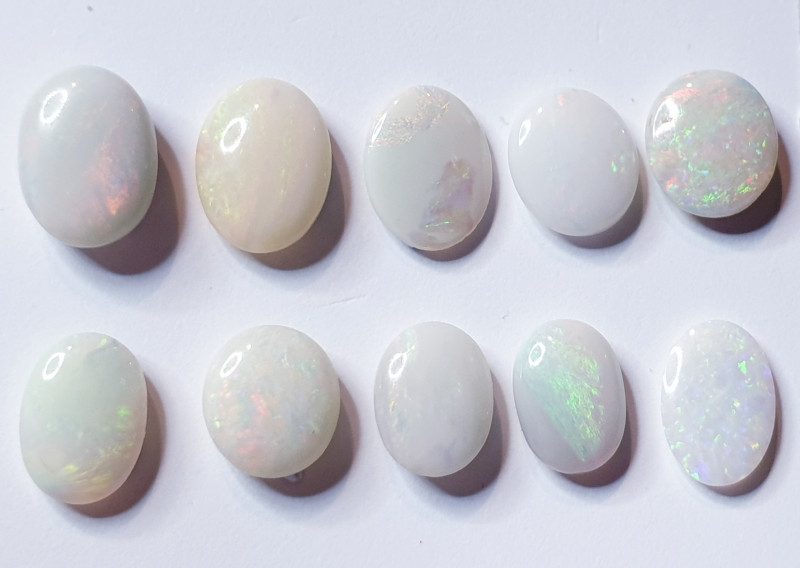
White Opal a ɛyɛ fitaa
White anaa light opal ne opal kɔla a wɔtaa de di dwuma , na ɛma ɛyɛ nea ne bo yɛ den. Ɛno akyi no, opal fitaa bo a ɛwɔ carat biara mu no gu ahorow kɛse.
Opal fitaa a ɛnyɛ papa betumi ayɛ nea ɛba fam te sɛ dɔla 10 wɔ carat biara mu. Eyinom taa yɛ mununkum na ɛnyɛ nea ɛda adi a kɔla nni agoru biara. Saa bere yi nyinaa, opal fitaa a ɛyɛ papa betumi adu dɔla 6,000 wɔ carat biara mu.
Opal fitaa a ɛyɛ papa no bɛn nea ɛda adi pefee, enni nneɛma a wotumi hu a wɔde ka ho, na ɛda kɔla a wɔde di agoru a ɛkyɛn so adi a ɛhyerɛn a emu yɛ den a ɛnyɛ nea ɛkɔ baabiara.
Nanso, opal fitaa a ɛyɛ hann no kyerɛ sɛ play-of-color ntumi nna adi pefee te sɛ opal tuntum da.
White opal bo a wɔbɔ wɔ carat biara ho no gyina wɔn grade ne nipadua nne so (N7 kosi N9):
N7 Opals : $10 kosi $2,400 wɔ carat biara mu (mfinimfini $150 kosi $500 wɔ carat biara mu)
N8 Opals : $10 kosi $2,200 wɔ carat biara mu (mfinimfini $70-$250 wɔ carat biara mu)
N9 Opals : $1 kosi $2,000 wɔ carat biara mu (mfinimfini $15 kosi $90 wɔ carat biara mu)
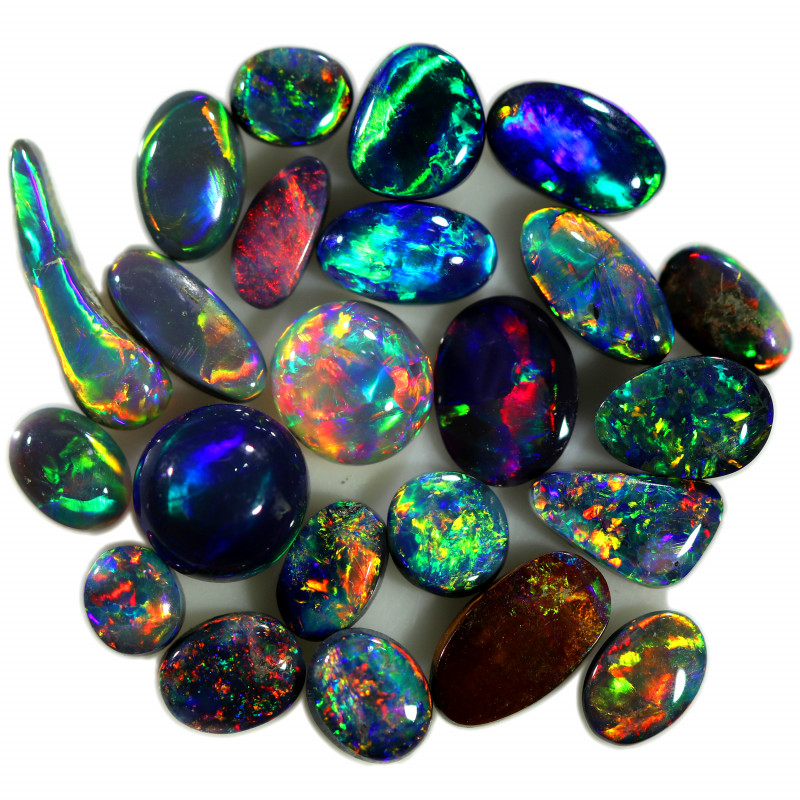
Opal a ɛyɛ sum & tuntum
Dark-toned opals, titiriw nea efi Lightning Ridge, ka opal ahorow a ɛsom bo sen biara no ho.. Ɛtɔ mmere bi a ebetumi ayɛ fitaa, tuntum, anaa bruu tuntum mpo, enti wɔsan frɛ no “dark opals.” Wɔn bo a ɛsom no fã bi fi nsonsonoe a ɛda akyi a ɛyɛ tumm ne kɔla a wɔde di agoru a ɛhyerɛn ntam.
Wopɛ sɛ wohwehwɛ abɔde mu opals wɔ saa ɔfã yi mu?
Sotɔ Black Opals
Sɛnea saa ahorow yi som bo no, hann ho hia sen nipadua no nne na abo a ɛnyɛ hann no som bo sen ahwehwɛ tuntum opals a ɛyɛ mmerɛw .
N1 kosi N4 abo bo:
Carat 1 kosi 10 : $10 kosi $16,000 wɔ carat biara mu
Bɛboro carat 10 : $10 kosi $20,000 wɔ carat biara mu
Mid-range quality N1 kosi N4 bo fi $300 kosi $1,400 wɔ carat biara mu.
Botae a ɛwɔ abo a wɔfrɛ no N5 kosi N6 (“opals tuntum”):
Carat 1 kosi 5 : $10 kosi $5,000 wɔ carat biara mu
5 kosi 10 carat : $10 kosi $7,000 wɔ carat biara mu
10+ carats : $10 kosi $6,400 wɔ carat biara mu
Mid-range quality dark opals kɔ $300 kosi $1,200 wɔ carat biara mu a carat mu duru mfa ho.

Common Opals a Wɔde Kɔla Ayɛ
Bo a wɔbɔ ma opals a wɔtaa de kɔla (a kɔla-agoru biara nni mu) dodow no ara gyina nea ɛntaa nsi so:
Green : $0.40 kosi $15 wɔ carat biara mu
Purple (Morado) : $0.50 kosi $5 wɔ carat biara mu
Blue : $50 kosi $250 wɔ carat biara mu
Pink : $0.50 kosi $150 wɔ carat biara mu
Na kɔkɔɔ, borɔdɔma, ne kɔkɔɔ nso ɛ? Wɔn nyinaa bu akontaa sɛ ogya opal!
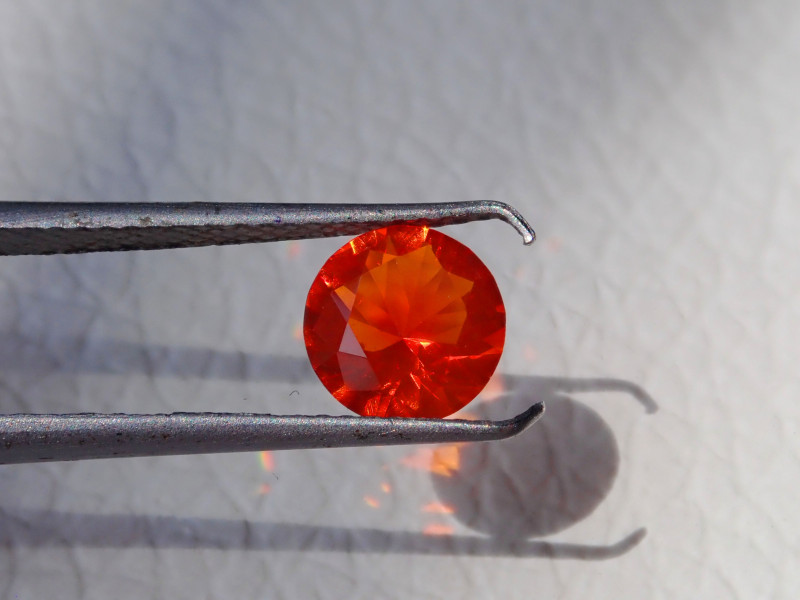
Ogya Opals
Wɔfrɛ opal a ɛyɛ kɔkɔɔ, borɔdɔma, kɔkɔɔ, anaa kɔla ahorow yi a wɔaka abom no ogya opal. Ebetumi ayɛ nea abu so anaasɛ ɛsom bo, na nea etwa to no ho yɛ na na ne bo yɛ den. Ogya opal a ɛsom bo sen biara no yɛ nea ɛda adi, ne kɔla yɛ pɛ, na ɛyɛ kɔkɔɔ-akutu anaa kɔkɔɔ a ɛhyerɛn.
Nhwɛsode a agye din sen biara ne Mexico ogya opal, nanso Australia ne Ethiopia nso yɛ ogya opal. Ogya opals nso yɛ soronko wɔ sɛnea ɛtaa yɛ nea ɛyɛ hann kosi nea ɛda adi na ɛtaa yɛ afã horow no mu. Mexicofo nhwɛsode taa yɛ ogya opal a wɔtaa yɛ, bere a Ethiopia yɛ ogya opal a ɛsom bo a ɛsom bo kɛse a neon violet ne kɔla ahabammono a wɔde di agoru wom.
Faceted fire opal bo fi $10 kosi $250 wɔ carat biara mu. Fire opal cabochon bo yɛ $25 kosi $300 wɔ carat biara mu, anaasɛ $25 kosi $135 wɔ carat biara mu sɛ ɛwɔ in-matrix a.

Opals a ɛyɛ mmerɛw: Crystal, Jelly, Contraluz & Hyalite
Ɛwom sɛ ɛntaa mma sɛ opals mu ntumi nhu ade yiye de, nanso ahorow kakraa bi wɔ hɔ a wonim sɛ enni kɔla na ɛyɛ transpadan ka: ahwehwɛ opal, jelly opal, contraluz, ne hyalite.
Wobu crystal opal sɛ ɛyɛ ahorow a ɛsom bo sen biara no mu biako wɔ opals a ɛyɛ tuntum akyi. Saa opal a ɛsom bo yi nni kɔla, ɛyɛ nea ɛda adi, ɛnyɛ nufusu, na ɛwɔ N7 kosi N8 wɔ nipadua no nne nsenia mu.
Crystal opal bo a wɔbɔ sɛnea carat mu duru te ni:
Carat 1 kosi 5 : $2 kosi $6,000 wɔ carat biara mu
Carat 5 kosi 10 : $2 kosi $6,400 wɔ carat biara mu
10+ carats : $2 kosi $6,000 wɔ carat biara mu
Nea edi hɔ ne jelly opals , a wɔsan frɛ no nsu opals. Eyinom yɛ opal a ɛsom bo a enni kɔla na ɛyɛ mmerɛw a ɛte sɛ gelatinous. Wɔyɛ tuntum kakra sen crystal opals.
Mpɛn pii no, jelly opal bo fi dɔla 5 kosi dɔla 140 wɔ carat biara mu.
Contraluz opals yɛ opals a ɛsom bo a enni kɔla a ɛte sɛ nea kɔla-agoru a ɛsensɛn mu bere a wufi akyi hyerɛn no.
Contraluz opal bo fi dɔla 150 kosi dɔla 200 wɔ carat biara mu.
Nea etwa to ne hyalite , opal a abu so a enni kɔla, kɔkɔɔ a ɛyɛ mmerɛw anaa ahabammono a ɛwɔ ahabammono a ano yɛ den fluorescence. Hyalite opal bo fi dɔla 6 kosi bɛyɛ dɔla 1,000 wɔ carat biara mu.
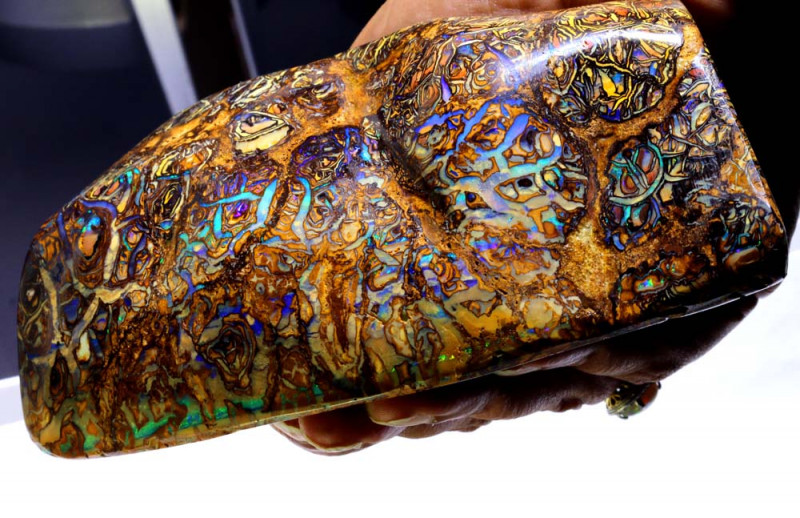
Abotan ne Matrix Opals
Boulder opal yɛ dade anaa anhweatam a ɛwɔ nsensanee ne/anaasɛ opal a ɛsom bo a ɛyɛ tratraa a ɛbata ho wɔ abɔde mu. Matrix opal te saa ara, nanso opal a ɛsom bo no hyɛ ntokuru anaa ntini a ɛda ɔbotan no nnua ntam ma, na ɛma kɔla-agoru kyekyɛ kɛse wɔ ne nyinaa mu.
Boulder ne matrix opal bo wɔ ɔfã koro no ara mu:
Carat 1 kosi 5 : $10 kosi $1,000 wɔ carat biara mu (mfinimfini $100 kosi $180 wɔ carat biako mu) .
5 kosi 10 carat : $10 kosi $2,000 wɔ carat biara mu (mfinimfini $90 kosi $200 wɔ carat biako mu) .
Carat 10 kosi 15 : $10 kosi $5,000 wɔ carat biako mu (mfinimfini $120 kosi $400 wɔ carat biako mu) .
15+ carats : $10 kosi $8,000 wɔ carat biara mu (mfinimfini $200 kosi $600 wɔ carat biara mu)
Ebia subtypes bi bo yɛ den, te sɛ Yowah nnuaba.
Opals a Wɔabom Ayɛ: Doublets & Triplets
Doublet ne triplets yɛ ade a ɛnyɛ den sɛ wobɛfa opal a ɛyɛ den ananmu. Ɛkame ayɛ sɛ wobetumi ayɛ opal biara ayɛ no doublet, enti ɛsono ne bo wɔ opal ko a wɔde di dwuma no mu.

Wɔ Opal Auctions ha no, yɛn doublet opals no fi $0.90 kosi bɛyɛ $230 wɔ carat biara mu. Yɛn triplet opals no fi $1 kosi bɛyɛ $170 wɔ carat biara mu.
Opals a Wɔde Nneɛma Ayɛ
Ade foforo a ɛnyɛ den sɛ wobɛfa so ayɛ saa ne opal a wɔayɛ. Opal ahorow bi wɔ hɔ a agye din a wɔde ayɛ a wubetumi apaw bi, nso.
Mpɛn pii no, aurora opals no bo nyɛ dɔla biako wɔ carat biara mu. Mpɛn pii no, opalite aboɔden abo a wɔayɛ no yɛ $1 kosi $3 biara. Dragon home opals fi ase bɛyɛ $4 na emu biara du $75. Sterling (anaa Monarch) opal fi ase bɛyɛ dɔla 4 na emu biara du dɔla 450.
 Woasiesie Wo ho sɛ Wobɛhwehwɛ Opal a Ɛyɛ Pɛ ama Wo?
Woasiesie Wo ho sɛ Wobɛhwehwɛ Opal a Ɛyɛ Pɛ ama Wo?
Sɛnea wubetumi ahu no, opal bo a wɔde bɛhyɛ mu no yɛ nea ɛyɛ den, nanso ɛno te saa esiane sɛ opals yɛ aboɔden abo soronko a egu ahorow saa nti. Sɛ wunim nea ɛkɔ opal bo ne opal grading mu a, ebetumi aboa wo ma woanya ahotoso sɛ worenya nea eye sen biara.
Woasiesie wo ho sɛ wobɛtɔ? Browse abɔde mu opals nyinaa a wɔtɔn anaa hwehwɛ Black Opals tẽẽ
搜尋Opal Encyclopedia
相關拍賣
相關文章
Boulder Opal yɛ opal a ne bo nyɛ den a ɛsom bo wɔ gua so no mu biako. Sua pii fa opal soronko yi ho na hwehwɛ abo a ɛyɛ fɛ a yɛwɔ a yɛtɔn no mu.
29th May 2019
Esiane sɛ Wayne ne Estella Sedawie ani gye opals ho nti, wɔde Opal Plus sii hɔ bɛboro mfe 14 a atwam ni na wɔahu sɛ intanɛt yɛ adwinnade a ɛsom bo. Ɛhɔ na adwumakuw no amanaman ntam nkitahodi dodow no ara kɔ so.
17th Oct 2018
Ɔbo a wɔde yɛ October no ne aboɔden abo a yɛpɛ paa, Opal. efi Black Opals, Mexico Opals ne Ethiopian Opals nyinaa yɛ soronko te sɛ nnipa a wɔwoo wɔn wɔ October mu no
3rd Oct 2019
最新的文章
Black opals ne opal ahorow a wɔhwehwɛ sen biara, na ne nnyinaso a emu dɔ ma nyankontɔn a ɛyɛ hann wɔ soro. Hu sɛnea wɔde opal tuntum di dwuma, ne su, abakɔsɛm, ne bo a ɛsom!
7th Dec 2025
Bra akwantuo mu na sua opals ayaresa tumi ho asɛm firi yɛn ahɔhoɔ kyerɛwfoɔ Vivien Schapera a ɔfiri Crystal Healing Techniques hɔ!
20th May 2023
Flame (anaa Ogya) Queen opal ne opal a ne bo yɛ den sen biara wɔ wiase, na wɔtɔn no nnɛyi sika a ɛne dɔla ɔpepem 3 yɛ pɛ. Sua n’abakɔsɛm ne ne su ahorow nyinaa!
18th Feb 2023
文章類別
All there is to know about Opals including Black Opals, Ethiopian Opals & Boulder Opal
14文章
Check out our fascinating information and articles on all things amazing in the Opal world
41文章





![4.55 CTS PARCEL OF CRYSTAL OPALS - LIGHTNING RIDGE[SCO31 ]](https://liveplatforms-production.b-cdn.net/tenants/oa/uploads/images/625000-629999/629404/5865df0f4b88e.jpg?width=480&aspect_ratio=1001%3A1000)
![2.40 CTS PARCEL OF CRYSTAL OPALS - LIGHTNING RIDGE[SCO23 ]](https://liveplatforms-production.b-cdn.net/tenants/oa/uploads/images/625000-629999/629381/5865bf1bceede.jpg?width=480&aspect_ratio=1001%3A1000)
![2.90 CTS PARCEL OF CRYSTAL OPALS - LIGHTNING RIDGE[SCO9 ]](https://liveplatforms-production.b-cdn.net/tenants/oa/uploads/images/625000-629999/629323/5864b3f9b6843.jpg?width=480&aspect_ratio=1001%3A1000)
![3.65 CTS PARCEL OF CRYSTAL OPALS - LIGHTNING RIDGE[SCO5 ]](https://liveplatforms-production.b-cdn.net/tenants/oa/uploads/images/625000-629999/629316/5864b1699c03f.jpg?width=480&aspect_ratio=1001%3A1000)